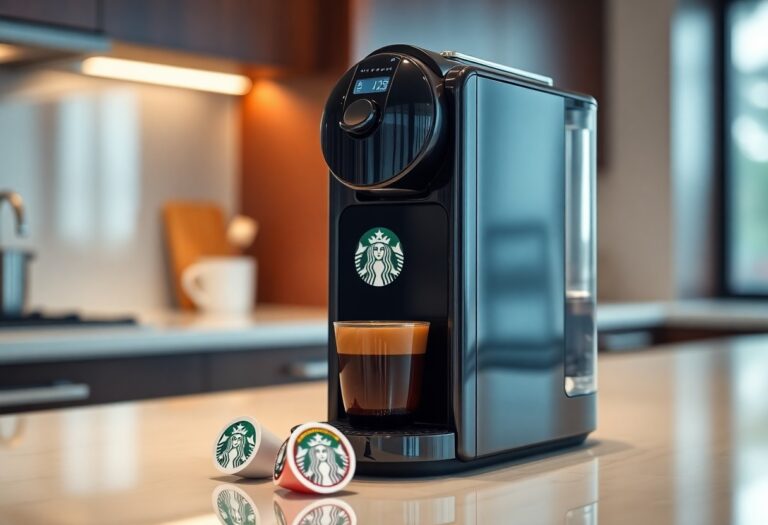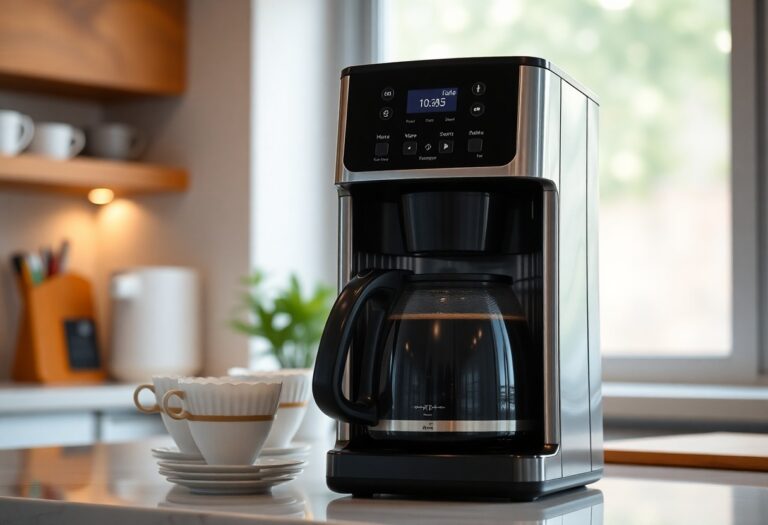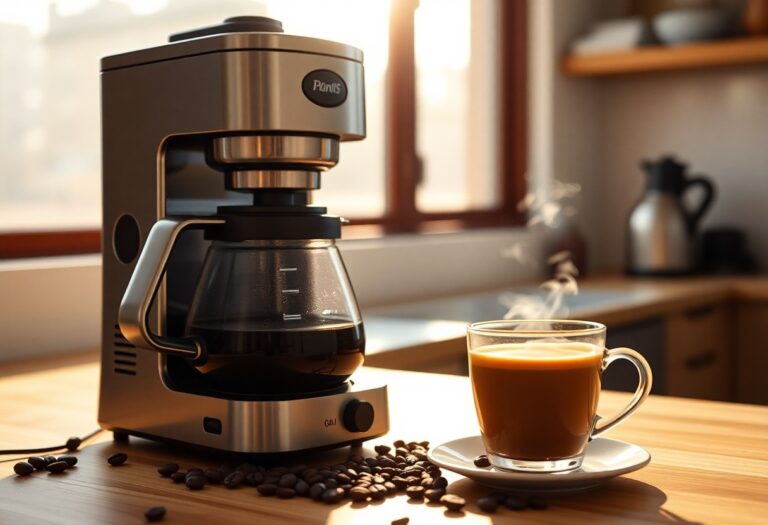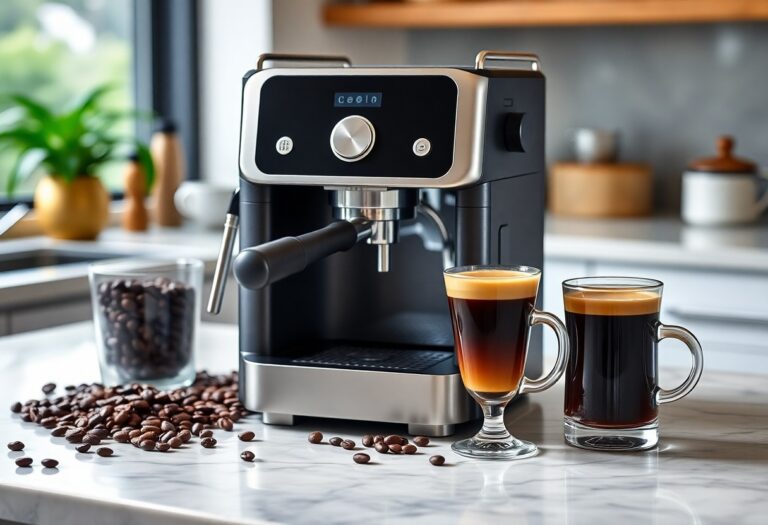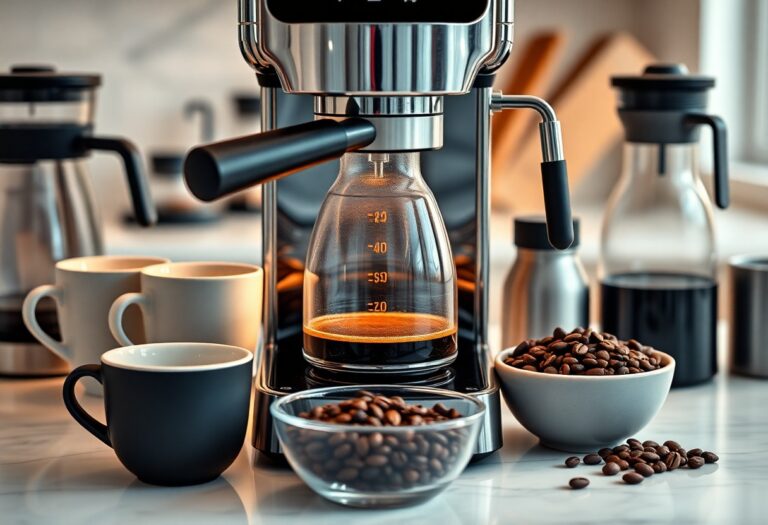What Size Inverter to Run a Coffee Machine – Power Requirements
Inverter selection is key to ensuring your coffee machine operates efficiently and safely. You need to understand your coffee machine’s power requirements to choose the appropriate inverter size. Typically, coffee machines demand surge power during startup that can be several times higher than their running wattage. Assessing the wattage of your specific model will help prevent damage to your equipment. By understanding these power demands, you can make informed decisions that keep your coffee brewing smoothly and prevent potential equipment failures.

Key Takeaways:
- The power requirements of coffee machines typically range between 800 to 1500 watts, depending on the type and size of the machine.
- For continuous operation, it’s advisable to choose an inverter that offers at least 20-25% more wattage than the coffee machine’s peak power consumption.
- Inverters can have a surge rating, which is important to accommodate the initial power spike when starting the coffee machine.
- Consider additional devices that may be used along with the coffee machine to determine the total power requirement and select an appropriate inverter size.
- Ensure the inverter’s output voltage matches the coffee machine’s operating voltage to prevent damage and ensure optimal performance.
The Electrical Demands of Coffee Machines
Understanding the electrical demands of coffee machines helps you choose the right inverter for your needs. Different machines have varying requirements that impact their overall performance. While a standard drip coffee maker may operate efficiently at lower wattages, high-end espresso machines can consume significantly more power, often requiring up to 1500 watts or more. Knowing your specific machine’s power needs allows you to select an inverter that can handle these requirements without risk of damage or inadequate performance.
Power Ratings: Watts vs. Amps
Power ratings can be expressed in two ways: watts and amps. Watts measure the total energy consumed, while amps indicate the current flowing through the circuit. To calculate the wattage requirements for your coffee machine, you can multiply the amps by the voltage (typically 120V or 240V). For instance, if your machine draws 10 amps at 120V, the power requirement is 1200 watts. Both measurements are important for selecting an appropriate inverter.
Continuous vs. Surge Power Needs
Every coffee machine has two power demands: continuous power and surge power. Continuous power is the wattage required for normal operation, while surge power is the additional wattage needed to start the machine, which often happens for just a few seconds. Investing in an inverter with a surge capacity exceeding your machine’s initial surge requirement is vital to ensure uninterrupted operation and prevent potential damage.
Many coffee machines, especially those with motors or heating elements, may experience a surge power need that is up to two to three times higher than their continuous power consumption. For example, a coffee maker that operates at 1200 watts continuously may require around 2400 to 3600 watts during start-up. Choosing an inverter that accommodates this higher surge capacity can prevent your coffee machine from tripping the inverter and ensures smooth operation right from the first brew. Always refer to your machine’s specifications for accurate power ratings to make informed decisions on your inverter selection.
Choosing the Right Inverter Size
Determining the appropriate size of your inverter involves understanding not only the wattage of your coffee machine but also its peak power requirements during startup. Coffee machines can have surge wattages that exceed their running wattages, often requiring more energy when first activated. For instance, if you plan to run a 950W coffee maker, it’s advisable to opt for an inverter that can handle more, ideally above 2000W, to accommodate the startup surge.
Calculating Required Inverter Capacity
Your inverter must be able to supply sufficient wattage to cover both the running wattage and any additional surge requirements. Start by identifying your coffee maker’s continuous wattage and adding approximately 20-30% to account for any fluctuations in power consumption. This buffer ensures that your inverter operates efficiently without overloading, providing you the peace of mind while enjoying your morning brew.
Accounting for Additional Appliances
If you plan to run additional appliances alongside your coffee machine, their wattage must also be factored into your inverter size calculation. Each device draws a portion of the total wattage, and exceeding the inverter’s capacity can lead to system failures or damage.
When considering additional appliances, think about not just your coffee machine but also a toaster, blender, or kettle you may use simultaneously. For example, if your coffee maker uses 950W, and you plan to run a toaster (800W) at the same time, you need an inverter that can handle at least 1750W, plus that additional 20-30% buffer. Be sure to add the wattages of each appliance together to avoid underestimating your total power needs. With the right calculations, you can ensure that your coffee indulgence won’t trip any circuits or lead to unexpected downtime.

Real-World Application: Sizing the Inverter for Your Coffee Machine
In practice, sizing the inverter for your coffee machine requires you to assess both peak and continuous power needs. Most coffee machines need a reliable inverter capable of handling brief spikes in power during operation. For a comprehensive approach, refer to the Go Power! Inverter Sizing Guide Power Solution, which provides valuable insights into selecting an inverter tailored to your specific setup.
Evaluating Different Coffee Machine Models
Not all coffee machines have the same power requirements, so evaluating various models is vital. For example, a single-serve pod machine might only draw around 800 watts, while a commercial espresso machine could peak at around 1500 watts or more. Looking at these rated specifications allows you to choose an inverter that can seamlessly support your coffee machine’s demands.
Recommendations for Typical Use Cases
For most standard home coffee setups, an inverter rated between 1500 to 2000 watts should suffice. Residential models, especially drip or single-serve machines, typically don’t demand as much power. In contrast, if you’re using high-capacity equipment like an espresso machine frequently, an inverter with a higher wattage capacity, possibly around 3000 watts, would be advisable to ensure smooth operation.
Your specific use case will heavily influence the inverter size you need. If you’re brewing coffee occasionally for personal use, a standard inverter in the 1500-2000 watt range will cover your needs. However, if you plan to serve multiple cups in quick succession or use additional appliances simultaneously—like grinders or milk frothers—consider an inverter that exceeds 3000 watts. This will provide the extra safety buffer to accommodate any unforeseen power surges while ensuring all equipment operates optimally.
Pitfalls to Avoid When Sizing Your Inverter
Choosing the wrong inverter size can compromise your coffee brewing experience. Avoiding common pitfalls ensures that you select an inverter that meets your power requirements without breaking the bank or risking appliance damage.
Overestimating Power Needs
Many people fall into the trap of overestimating their power needs by opting for an inverter with significantly more capacity than necessary. This not only leads to higher costs but can also result in inefficiencies, especially when operating a coffee machine that requires only moderate wattage to function properly.
Underestimating Duty Cycles
Underestimating the duty cycles of your coffee machine can lead to *power interruptions* that affect performance. Most coffee machines do not run continuously at their maximum wattage; they cycle on and off depending on the brewing process. Failing to account for these duty cycles can lead to selecting an inverter that doesn’t handle peak demands effectively.
Being aware of duty cycles is key for optimal inverter selection. For instance, if your coffee machine has a 1000-watt brewing phase but typically operates at 600 watts while in standby mode, an inverter rated for solely 1000 watts might not provide the support you need during those peak moments. Assess your machine’s operational patterns closely—understand how long it draws maximum power versus how often it rests. This will guide you toward choosing an inverter that can handle both the peaks and lows efficiently, ensuring seamless coffee brewing without interruptions.
The Future of Coffee Tech: Energy Efficiency Trends
The coffee industry is rapidly evolving, with a significant push towards energy efficiency. Innovations in technology and design are streamlining energy consumption and reducing waste, allowing you to enjoy your favorite brew while minimizing your environmental footprint. These trends not only promise improved performance but also help in lowering operational costs for both home and commercial setups.
Innovations in Coffee Machine Design
Modern coffee machines are now integrating smart technologies and energy-efficient components. Features like automatic shut-off, customizable brew settings, and advanced thermal regulation not only enhance user experience but also reduce energy consumption. Compact designs utilize less material and space, emphasizing efficiency while maintaining high cup quality.
The Role of Renewable Energy Solutions
Utilizing renewable energy sources, such as solar or wind power, can greatly enhance the sustainability of your coffee-making process. By installing solar panels or small wind turbines, you can generate your own clean energy, effectively powering your coffee machine without relying on traditional electricity sources. This not only reduces your carbon footprint but also can lead to substantial savings on energy costs over time.
For instance, if you install a solar system capable of generating 2kW of power, you can potentially offset the energy used by your coffee machine, especially during peak sunlight hours. This shift not only promotes sustainability but also integrates seamlessly with energy management systems that can optimize power usage for all your kitchen appliances. As these solutions become more accessible and affordable, the future of brewing coffee sustainably is shaping into an enticing reality.
Final Words
From above, it’s evident that selecting the right size inverter for your coffee machine involves understanding the power requirements and wattage of your specific model. You need to ensure that the inverter can handle not just the wattage of the coffee machine during operation, but also consider the starting surge power if applicable. By calculating the total watts needed and factoring in a safety margin, you can make an informed decision that ensures your coffee machine runs effectively without interruptions.
FAQ
Q: What is the typical power requirement for a standard coffee machine?
A: The power requirement for a standard coffee machine can vary, but most models typically use between 800 to 1500 watts. It’s vital to check the manufacturer’s specifications for your specific coffee machine to determine its exact power consumption.
Q: How do I determine what size inverter I need for my coffee machine?
A: To determine the appropriate size inverter for your coffee machine, first identify the wattage required by your machine. Then, choose an inverter that can handle at least 20% more than that wattage to accommodate any potential surges during operation. For example, if your coffee machine uses 1200 watts, an inverter rated at 1500 watts or higher is advisable.
Q: Are there different inverter types suitable for coffee machines?
A: Yes, there are different types of inverters, primarily modified sine wave and pure sine wave inverters. For running a coffee machine, pure sine wave inverters are generally recommended as they provide stable power and are compatible with sensitive electronics, ensuring optimal performance of your appliance.
Q: Can I use a smaller inverter if my coffee machine has a lower watt setting?
A: While you might consider using a smaller inverter if your coffee machine has a lower watt setting, it’s important to select an inverter that meets the maximum wattage the machine can draw during peak operation. Using an inverter that’s too small can lead to overload, potentially damaging both the inverter and the appliance.
Q: Is it safe to run a coffee machine on an inverter during outdoor camping or RV trips?
A: Yes, it is generally safe to run a coffee machine on an inverter while camping or during RV trips, provided the inverter is correctly sized and installed. Ensure that your battery system can provide sufficient power and that the inverter is connected properly to handle the coffee machine’s wattage requirements without exceeding the inverter’s capacity.



